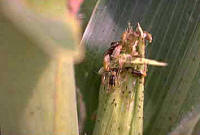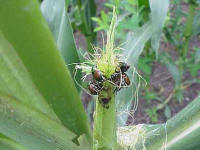|
The
farm situation:
Drought, Japanese beetles, rootworm beetles, spider mites, potato
leafhoppers challenge local crops
 Send a link to a friend
Send a link to a friend
By John Fulton
[JULY 7, 2005]
The farm situation has certainly taken a hit
the last few weeks. The lack of meaningful rain has drastically
reduced the potential corn yield in some areas of the county. Other
areas receiving more rainfall are still looking at yields greatly
reduced from the past two lofty seasons.
|
|
Corn can lose about 2 percent of its yield potential per day
just prior to tasseling. Once the tassel emerges, the losses can
reach 6 percent per day. With the extremely dry soil, a
half-inch rain may relieve drought symptoms for a couple of
days.
Soybeans tend to be more tolerant of drought conditions, as
long as the rains come by mid-August. The bean plants tend to
lose more blooms until that point, but bloom abortion of 75
percent is not uncommon in better years.
At this point, crops in the driest areas are just "hanging
on." The crops are really just waiting for conditions to
improve. The greatest concern, other than drought, is the large
number of insects challenging our crop.

Corn rootworm beetles [click on picture for
larger image]
Corn rootworm beetles are out this year ahead of silking. Add
to that, impressive numbers of Japanese beetles in some areas of
the county, and additional pollination problems are possible.
Treatment thresholds for rootworm beetles in corn are five or
more beetles per plant, pollination not yet complete, and silk
clipping occurring. Japanese beetle adult problems are similar,
with protection of pollinating plants the main goal of scouting.
Thresholds are three or more beetles per plant, pollination not
yet complete, and silk clipping occurring.

Japanese beetles [click on picture for larger
image]
[to top of second column in this article] |

Soybeans are continuing to have spider mite problems in localized
areas. Thresholds for treatment are about 15 percent discoloration
of leaves for spider mites in soybeans setting pods. Japanese
beetles are also affecting spots in soybean fields. Treatments for
the beetles should be applied when 20 percent defoliation occurs in
soybeans at our current growth stages.
Moisture conditions have also led to a shorter hay crop this
year, and growers need to pay particular attention to controlling
potato leafhoppers in alfalfa. The leafhopper feeds on leaf tips,
then injects a toxin into the plant. Symptoms are a yellow "v" at
the leaf tip at initial feeding. Treatment is justified on any size
of large alfalfa when two leafhoppers are caught in a single sweep
of a sweep net. Three-inch-tall alfalfa justifies treatment when one
leafhopper is caught in five sweeps.
[John
Fulton, unit leader,
University of Illinois Extension,
Logan County Unit]
 |